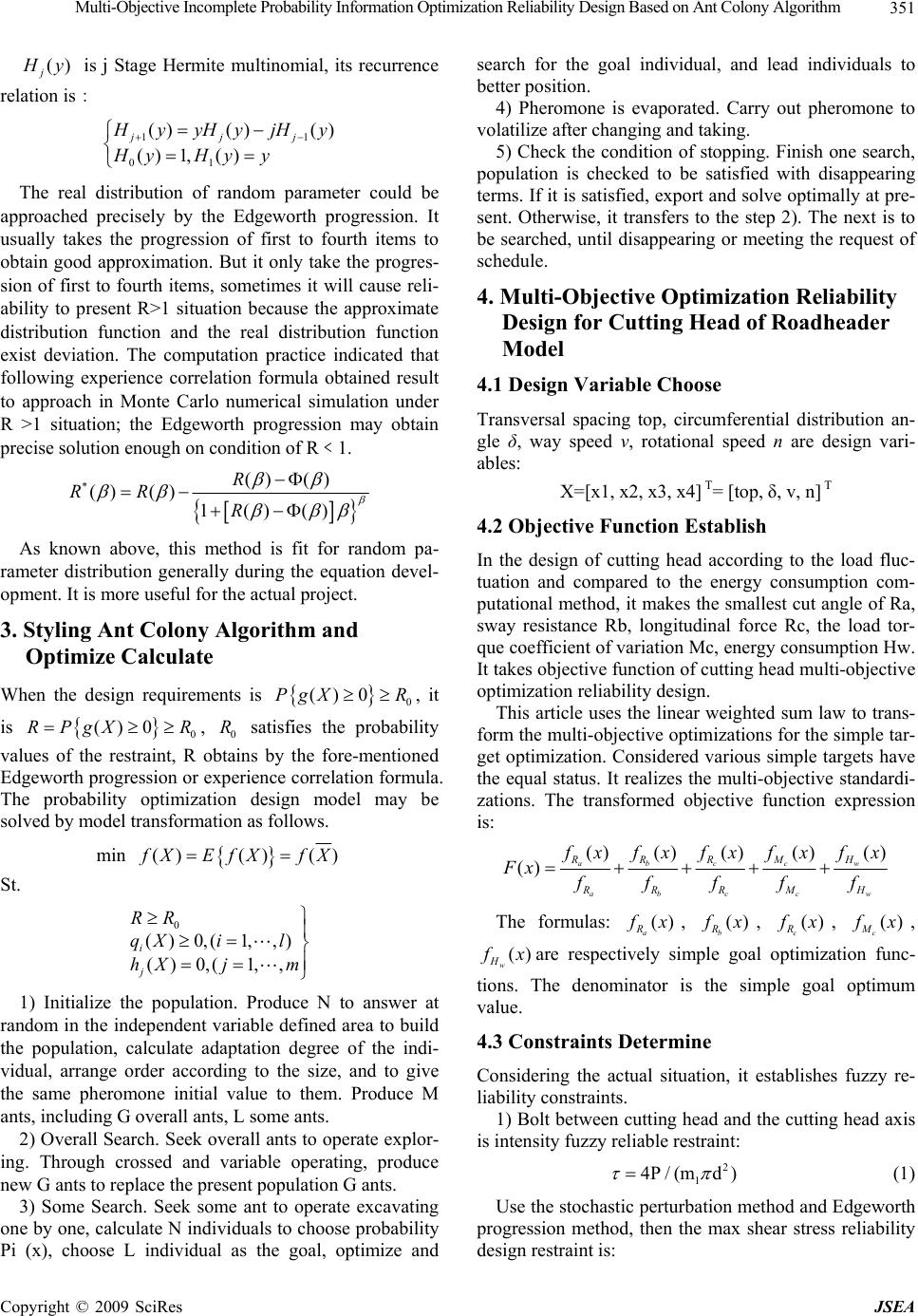
Multi-Objective Incomplete Probability Information Optimization Reliability Design Based on Ant Colony Algorithm351
()
j
y is j Stage Hermite multinomial, its recurrence
relation is:
11
01
() ()()
() 1,()
jjj
yyHyjHy
HyHy y
The real distribution of random parameter could be
approached precisely by the Edgeworth progression. It
usually takes the progression of first to fourth items to
obtain good approximation. But it only take the progres-
sion of first to fourth items, sometimes it will cause reli-
ability to present R>1 situation because the approximate
distribution function and the real distribution function
exist deviation. The computation practice indicated that
following experience correlation formula obtained result
to approach in Monte Carlo numerical simulation under
R >1 situation; the Edgeworth progression may obtain
precise solution enough on condition of R﹤1.
() ()
() ()
1()()
R
RR
R
As known above, this method is fit for random pa-
rameter distribution generally during the equation devel-
opment. It is more useful for the actual project.
3. Styling Ant Colony Algorithm and
Optimize Calculate
When the design requirements is , it
is , satisfies the probability
values of the restraint, R obtains by the fore-mentioned
Edgeworth progression or experience correlation formula.
The probability optimization design model may be
solved by model transformation as follows.
0
() 0PgX R
0
() 0RPgXR
0
R
min
()() ()
X EfXfX
St.
0
() 0,(1,,)
() 0,(1,,
i
j
RR
qX il
hX jm
1) Initialize the population. Produce N to answer at
random in the independent variable defined area to build
the population, calculate adaptation degree of the indi-
vidual, arrange order according to the size, and to give
the same pheromone initial value to them. Produce M
ants, including G overall ants, L some ants.
2) Overall Search. Seek overall ants to operate explor-
ing. Through crossed and variable operating, produce
new G ants to replace the present population G ants.
3) Some Search. Seek some ant to operate excavating
one by one, calculate N individuals to choose probability
Pi (x), choose L individual as the goal, optimize and
search for the goal individual, and lead individuals to
better position.
4) Pheromone is evaporated. Carry out pheromone to
volatilize after changing and taking.
5) Check the condition of stopping. Finish one search,
population is checked to be satisfied with disappearing
terms. If it is satisfied, export and solve optimally at pre-
sent. Otherwise, it transfers to the step 2). The next is to
be searched, until disappearing or meeting the request of
schedule.
4. Multi-Objective Optimization Reliability
Design for Cutting Head of Roadheader
Model
4.1 Design Variable Choose
Transversal spacing top, circumferential distribution an-
gle δ, way speed v, rotational speed n are design vari-
ables:
X=[x1, x2, x3, x4] T= [top, δ, v, n] T
4.2 Objective Function Establish
In the design of cutting head according to the load fluc-
tuation and compared to the energy consumption com-
putational method, it makes the smallest cut angle of Ra,
sway resistance Rb, longitudinal force Rc, the load tor-
que coefficient of variation Mc, energy consumption Hw.
It takes objective function of cutting head multi-objective
optimization reliability design.
This article uses the linear weighted sum law to trans-
form the multi-objective optimizations for the simple tar-
get optimization. Considered various simple targets have
the equal status. It realizes the multi-objective standardi-
zations. The transformed objective function expression
is:
() ()()()()
() abcc w
abc c
RRRMH
RRRMH
w
xfxfxfxfx
Fx ffff f
The formulas: ()
a
R
x, ()
b
R
x, ()
c
R
x, ()
c
M
x,
()
w
H
xare respectively simple goal optimization func-
tions. The denominator is the simple goal optimum
value.
4.3 Constraints Determine
Considering the actual situation, it establishes fuzzy re-
liability constraints.
1) Bolt between cutting head and the cutting head axis
is intensity fuzzy reliable restraint:
2
1
4P / (md)
(1)
Use the stochastic perturbation method and Edgeworth
progression method, then the max shear stress reliability
design restraint is:
Copyright © 2009 SciRes JSEA